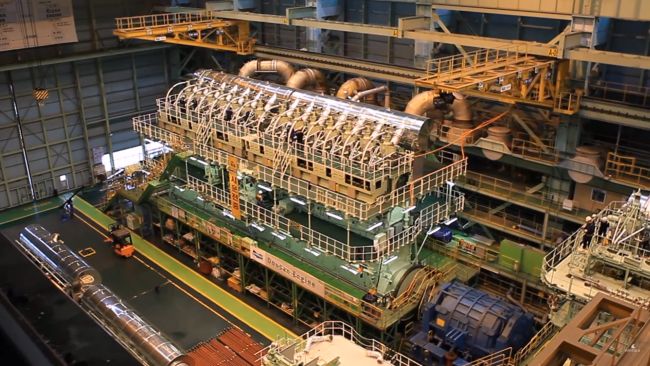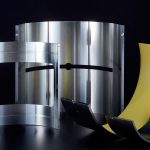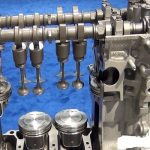Here is a diesel engine that you can really sink your teeth into. It’s built in Japan and my jaw dropped when I first saw this mega machine! I’m thinking about what the machining tools look like that built this thing?
The fuel costs amaze me (data below) and being a 2 stroke…how loud is this engine and what do the higher rpms do to the life of the engine?
PISTON AND CONNECTING ROD

ENGINE BLOCK

The Wartsila-Sulzer RTA96-C turbocharged two-stroke diesel engine is the most powerful and most efficient prime-mover in the world today. The Aioi Works of Japan’s Diesel United, Ltd built the first engines and is where some of these pictures were taken.
It is available in 6 through 14 cylinder versions, all are inline engines. These engines were designed primarily for very large container ships. Ship owners like a single engine/single propeller design and the new generation of larger container ships needed a bigger engine to propel them.
The cylinder bore is just under 38″ and the stroke is just over 98″. Each cylinder displaces 111,143 cubic inches (1820 liters) and produces 7780 horsepower. Total displacement comes out to 1,556,002 cubic inches (25,480 liters) for the fourteen cylinder version.
Some facts on the 14 cylinder version:
Total engine weight: 2300 tons (The crankshaft alone weighs 300 tons.)
Length: 89 feet
Height: 44 feet
Maximum power: 108,920 hp at 102 rpm
Maximum torque: 5,608,312 lb/ft at 102rpm
Fuel consumption at maximum power is 0.278 lbs per hp per hour (Brake Specific Fuel Consumption). Fuel consumption at maximum economy is 0.260 lbs/hp/hour. At maximum economy the engine exceeds 50% thermal efficiency. That is, more than 50% of the energy in the fuel in converted to motion.
For comparison, most automotive and small aircraft engines have BSFC figures in the 0.40-0.60 lbs/hp/hr range and 25-30% thermal efficiency range.
Even at its most efficient power setting, the big 14 consumes 1,660 gallons of heavy fuel oil per hour.
This an amazing diesel engine and I wonder if they will ever go hybrid? Just Kidding…I don’t think they would room for the battery pack. It would be one heck of an accomplishment. Japanese technology reigns supreme once again. It makes me wonder why they can build these huge machines in their own country and HOW A CRUISE LINE run them without going broke with the fuel costs & diesel engine maintenance. I would guess ticket sales would have to be adjusted UP (most times) in accordance with the price of fuel.
Check out this Detroit 8V 71 2 Stroke Diesel Running (Takes me back to the non emission control days…where there’s smoke there’s a screamin’ Jimmy!). Having 2 strokes instead of 4 makes it easy to understand how much higher the RPMs are. If I were these guys I would have rigged up a decent engine stand.


